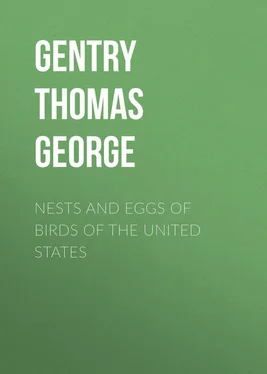Thomas Gentry - Nests and Eggs of Birds of The United States
Здесь есть возможность читать онлайн «Thomas Gentry - Nests and Eggs of Birds of The United States» — ознакомительный отрывок электронной книги совершенно бесплатно, а после прочтения отрывка купить полную версию. В некоторых случаях можно слушать аудио, скачать через торрент в формате fb2 и присутствует краткое содержание. Жанр: foreign_antique, foreign_prose, на английском языке. Описание произведения, (предисловие) а так же отзывы посетителей доступны на портале библиотеки ЛибКат.
- Название:Nests and Eggs of Birds of The United States
- Автор:
- Жанр:
- Год:неизвестен
- ISBN:нет данных
- Рейтинг книги:5 / 5. Голосов: 1
-
Избранное:Добавить в избранное
- Отзывы:
-
Ваша оценка:
- 100
- 1
- 2
- 3
- 4
- 5
Nests and Eggs of Birds of The United States: краткое содержание, описание и аннотация
Предлагаем к чтению аннотацию, описание, краткое содержание или предисловие (зависит от того, что написал сам автор книги «Nests and Eggs of Birds of The United States»). Если вы не нашли необходимую информацию о книге — напишите в комментариях, мы постараемся отыскать её.
Nests and Eggs of Birds of The United States — читать онлайн ознакомительный отрывок
Ниже представлен текст книги, разбитый по страницам. Система сохранения места последней прочитанной страницы, позволяет с удобством читать онлайн бесплатно книгу «Nests and Eggs of Birds of The United States», без необходимости каждый раз заново искать на чём Вы остановились. Поставьте закладку, и сможете в любой момент перейти на страницу, на которой закончили чтение.
Интервал:
Закладка:
This admirable piece of bird-architecture, which rivals in beauty and symmetry the nest of our little Ruby-throated Humming-bird, is either saddled upon a living or dead limb that is horizontal and lichen-clad, or else upon the crotch of a bifurcated branch, and is placed above the ground at elevations varying from five to thirty feet. According to Nutt all, "the body of the fabric" occasionally consists of "wiry grass or root fibres;" but we have yet to meet with a nest with " small branching lichens held together with cobwebs and caterpillars' silk, moistened with saliva," as that author remarks. In a structure before us, which is typical in its character, small strips of inner bark plucked from trees of chestnut and oak, bits of tow, and fragments of wool, circularly arranged and compactly pi-essed together, are the prevailing constituents. Externally, it is closely invested with the bluish-gray crustaceous lichens which are so plentiful upon the trunks of certain trees, and also upon fence-rails. In diameter, it measures three and a half inches; in height, one and a half inches. The width of the cavity is about two inches; the depth in the centre, three-fourths of an inch.
The most beautiful fabric, as well as the most compactly built, which we have seen, was obtained in the spring of 1870, not far from Germantown, Pa. It was placed upon a horizontal branch of an apple-tree, in close proximity to a farm-house. Externally, it is thickly covered with bluish-gray crustaceous lichens , which are held in place by a few cobwebs, and fragments of the silk of caterpillars. The base consists of dried stems of grasses, and on these is reared a neat and cosy superstructure composed of the inner fibres of the wild and cultivated species of the vine, and a slight sprinkling of wool. These materials are variously interwoven, and arranged around the margin so as to form a cavity. The dimensions of this nest are as follows: External diameter, three and a half inches; height, one and a half inches; width of cavity, two inches; depth in the centre, three-fourths of an inch. In the Plate it is represented the natural size – built upon an oak branch.
In the details of form and dimensions, this nest differs immaterially from specimens which we have met with and seen from other localities. But wherever obtained, they will always be found to bear a very close resemblance to one another, differing chiefly in the character of the articles which constitute the inner arrangement. We will merely mention one example which was taken by Mr. Welch, in Lynn, Mass., and which will give our readers some faint conception of the extent to which variation is often carried. This structure was placed upon a dead limb of a forest-tree. Its walls were composed of small dry stems and vegetable down, finely interwoven, and covered on the outside with lichens which were cemented to it by a viscid secretion that was apparently supplied by the builders. The base wras somewhat flattened, much thinner than the walls, and composed of finer materials. The external diameter was three inches, and the height one and a half inches; the cavity, two and a half inches at the rim, and the central depth about one inch.
Having finished their home, only a day or so intervenes when oviposition becomes the controlling instinct. The female now proceeds to deposit her complement of four eggs, which she does on consecutive days, at the rate of a single egg daily. This is followed, on the day succeeding the last deposit, by the trying duty of incubation. Upon the female devolves this arduous and irksome labor. For about eleven days she is thus engaged, until her patience is finally crowned with success. Although the male takes no part in this duty, yet he contributes his share to the prosperity of the undertaking, by guarding his partner from danger, and supplying her with the essential articles of food. When his home is assailed by feathered enemies, if they are not more than a match for his strength, he is not slow to wreak instant vengeance upon them. But in the case of human depredators, where effort would be futile, no exertion is put forth to cause desistance from any contemplated assault, save a little scolding.
The eggs are four in number, and resemble in configuration those of the common Phoebe-Bird. They are obtuse at one extremity, and slightly tapering at the other. The ground is a rich cream-color, and is diversified about the larger end with a wreath of purple and lilac spots, which are large, and occasionally confluent. In length, they measure .76 of an inch, and in width .54. It is pretty well established that but a single set is deposited by any given pair of birds in a season. Nests with eggs, however, have been taken during the last of July, or the beginning of August; but whether a second laying or not, we cannot say – possibly the work of birds whose early efforts had been frustrated.
Plate III. – MIMUS. CAROLINENSIS, Gray. – Cat-Bird
The Cat-Bird is one of the most common and conspicuous of all our feathered visitants. It reaches the United States from its Central American home, on or about the 10th of April, and thence diffuses itself over the whole country, northward as far as the Saskatchewan, and westward to the Rocky Mountains.
Immediately upon its arrival, it seeks the shelter of dense woods, or the security of waste fields and bramble-ridden hedges. In such situations, among the dead leaves that lie scattered upon the ground, it gleans a well-earned subsistence. But later, when the leaves begin to appear, and with them an abundance of insect-life, these retreats are deserted by a few venturesome individuals, and an abiding-place is sought amid the quiet scenes of rural gardens.
A week or ten days, however, elapse before the sexes are ready to assume conjugal relations. Being vigorous feeders, and living in the midst of plenty,' they are seemingly all unconscious of the better and nobler instincts of their being. But feeding eventually satisfies appetite, and conduces to the awakening of the amatory forces from their hitherto dormant condition. The males, by their altered demeanor, are the first to show signs of change. We no longer observe them engaged in the pursuit of the juicy caterpillar, or the gilded butterfly, with the same energy and zest as before. Their aims are higher, their aspirations loftier. Perched upon a small tree, or screened from observation by dense clumps of bushes, with heads bent skyward, they startle the echoes of woodland and valley with their strange, ecstatic music. But the females still continue feeding, as though utterly oblivious of the concert which is intended for their benefit. After a day or two thus spent, they become less absorbed in such matters, yield to the potency of song, and coyly emerge from obscurity to welcome and encourage their would-be suitors. The period of courtship is short, and unattended by any of those peculiar antics which characterize many species at this time.
In the Middle and Western States mating occasionally commences as early as the 25th of April, when the season is remarkably forward, but generally about the first of May – seldom later. In the Territories, from some unknown cause, it is delayed to a later period. Very little time is wasted after this event has occurred, in celebrating the occasion, for the pair soon begin to look for a proper nesting-place. This is a labor not entered into without previous care and deliberation. Ordinarily a week or ten days are spent in making a choice of locality. The site selected is usually a brier, cedar, thorn-apple, or a bush in the midst of a grove or hedge, seldom remote from a settlement. The nest is sometimes placed in a maple, and when such is the case, the birds take the precaution to build it pretty well up. During the summer of 1880, my son discovered one in a crotch of the red maple, at an elevation of thirty feet from the ground. This, however, is exceptional, as the height usually ranges from three to about twelve feet. It sometimes happens that an injudicious selection of locality has been made, and a nest has been nearly completed before the mistake is discovered. In this predicament, instead of "making the best of a bad bargain," the birds ignore the site for another better suited to their purposes. The situation being finally decided upon, both birds work diligently during the cooler hours of the morning and evening, for five or six days, in the construction of their home. In some instances, particularly during moonlit nights, the work has been carried on long after twilight has faded from the earth. Unlike the case of the Cedar-Bird, which we have already cited, there does not seem to be any regular division of labor. Both birds collect the materials, as well as arrange them in the nest. When a suitable article has been found, the finder does not fly immediately to the nest and adjust the piece, but indulges in short flights from one object to an adjoining one, carefully surveying the premises all the while, until within a few yards of the nest, when she rapidly flies thither, and having disposed of her burden, goes off in quest of others. Where accustomed to man, the Cat-Bird does not seem to be much annoyed by his presence.
Читать дальшеИнтервал:
Закладка:
Похожие книги на «Nests and Eggs of Birds of The United States»
Представляем Вашему вниманию похожие книги на «Nests and Eggs of Birds of The United States» списком для выбора. Мы отобрали схожую по названию и смыслу литературу в надежде предоставить читателям больше вариантов отыскать новые, интересные, ещё непрочитанные произведения.
Обсуждение, отзывы о книге «Nests and Eggs of Birds of The United States» и просто собственные мнения читателей. Оставьте ваши комментарии, напишите, что Вы думаете о произведении, его смысле или главных героях. Укажите что конкретно понравилось, а что нет, и почему Вы так считаете.












